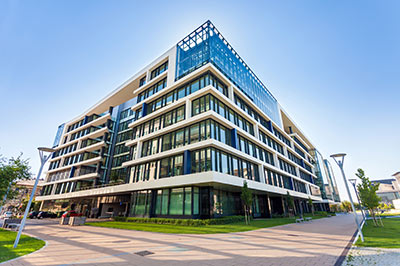By Dr. Linda Lemasters
Several years ago one of my doctoral students was appointed principal of a large inner city school. He shared with me his shock at his first visit: he said a horrible odor of urine and filth met him at the door. Hallways were dirty from years of use, with no paint; lockers were peeling and rusted; floors looked dirty because dirt had been covered with wax; dirt was so accumulated in corners that the floor could not be seen. Bathrooms were intolerable; no one would want to use them. The thought of elementary children using them was unthinkable. Classrooms were dingy, dirty, and uninviting; a long time had passed since the color of the walls was recognizable. It was only a few weeks before school was to begin; he knew that he had to do something—anything—to make the school more welcoming and appropriate for teaching and learning.
My student was conducting his doctoral research on how the conditions of the school facility affect student achievement; he was familiar with the research and the preponderance of the evidence exhibiting a very strong connection between the places were students learn and achievement. He also had an old, familiar dilemma: he knew things he needed to do, but had no funds for his building. Educators, however, do not always see a lack of funding as a reason not to get things done. He got his leadership team and office staff together to develop a plan. They decided to call for community cleaning days for the next weekend. Posters when up; calls went out. The principal contacted a couple of the local stores that sold paint and asked for any paint they were willing to donate, along with brushes, rollers, tape, and other supplies. Parents were asked to bring cleaning supplies, brooms, and mops—and friends and neighbors willing to work on both the inside and outside of the school property. Teachers were asked if they would volunteer to help paint and clean their classrooms and to make them inviting.
When school began the day after Labor Day, a miracle had happened. Teachers and students opened the front doors to a bright and clean foyer, newly painted hallways, and lockers that had been scrubbed down. Students entered freshly painted classrooms, with posters and bulletin boards that stood out on the clean walls. Although a great deal of the donated paint had been white, tints were added to make the colors warm and inviting. Restrooms were clean, painted, and smelled so much better. Teachers were bubbly and happy about the changes; office staff benefitted from the teacher excitement, and the leadership team felt they had started the year on the right foot.
There was a phenomenon that was just the opposite of the broken windows theory. Students, parents, teachers, and the community began to take great pride in their school and worked to continue the improvements begun during the work weekend. A few days after school opened, the principal arrived to large pots of flowers at each front door; a local business donated new playground equipment; and, there seemed to be a school climate change taking place. There was no research conducted on that particular school, but there is research that notes the condition of the school affects achievement. Let’s look at a few research projects that had findings supporting this.
Indeed, in a study titled Clean Schools Promote Academic Success conducted at the Center for Facilities Research, the Association of Higher Education Facilities Officers noted several interesting findings. Eighty-eight percent of college students reported that a lack of cleanliness became a distraction; 84% responded that orderly spotlessness and ordinary tidiness are essential to a positive learning environment; 78% noted that cleanliness affected their health. Students rated cleanliness the fourth most important building element to influence personal learning.
Many of the observations noted earlier were based on visual assessments. The International Sanitary Supply Association (ISSA) is actively involved in assisting school districts in realizing the importance of clean schools. The video How Dirty Is Your Child’s School notes some alarming statistics and germ hotspots. Some of those include water fountain spigots (2,700,000 bacteria per inch), cafeteria trays (33,800 bacteria per inch), cold water faucets (32,000 bacteria per inch), followed by the cafeteria plates, computer keyboards, and toilet seats.
In a report from the schools in New York City several years ago, 40% of those interviewed noted conditions in the schools that could cause complications to their allergies and asthma. Thirty-nine percent with medical conditions said the school conditions made their health worse. The Philip R. Lee Institute for Health Policy Studies (2010) reviewed the condition of schools and achievement in California. In student studies, student health was directly related to the condition of the school buildings and student achievement. In addition student health was directly related to attendance and dropout rates.
So, what is the real impact? The Healthy Schools Network published astonishing numbers on this topic:
- Nearly 22 million school days are lost annually to the common cold.
- Thirty-eight million days are lost each school year to influenza.
- Elementary students contract 8 to 10 bouts of colds or flu each school year.
- Student absences lead to a higher number of dropouts. Please note video below:
(https://www.youtube.com/watch?v=_nF7fN0WuUs)
- Only 43.5 percent of school districts provide guidance for infectious disease prevention.
We can say with a great deal of confidence that healthy schools have a positive influence on attendance, thus achievement. What we have not discussed is the monetary value. Most of what we hear is that school funds are being cut; custodial budgets are going down, rather than up; school maintenance can barely afford to make sure air exchange is appropriate, as well as filters being changed regularly.
There is a value, however, which can be placed on healthy schools and the prevention of student and teacher absences. For instance, teacher absences cost school districts an estimated $4 billion a year. While I could not find a single cost estimate related to student absences, the state information indicates that localities lose billions and billions to student absences, because most state funding formulas are based on student attendance. Thus, research indicates we cannot afford not to keep our schools clean and healthy. Students and teachers spend the majority of their days in school. If healthy schools mean healthier students and teachers, if healthier students and teachers mean more money to spend on instruction, and, if healthy schools are related to student achievement, then keeping schools ultra clean should be a moot point.
References:
Association of Higher Education Facilities Officers. (2008, June). Cleanliness and Learning in Higher Education. Education Facilities. Downloaded January 13, 2016 from http://www.facilitiesnet.com/educationalfacilities/article/Study-Clean-Schools-Promote-Academic-Success-Facilities-Management-Educational-Facilities-News--9072
Healthy Schools Network. (1999). Neglected Buildings, Damaged Health: A ‘Snapshot” of New York City Public School Environmental Conditions. Downloaded January 19, 2016 from http://www.healthyschools.org/clearinghouse.html
HR Exchange. (2013, February). National Teacher Absence Data Shines Light on the High Costs of Missed Days. Downloaded on January 19, 2016 from https://www.tasb.org/Services/HR-Services/Hrexchange/2013/February-2013/B-Absences-Costly.aspx
International Sanitary Supply Association. (2016). How Dirty Is Your Child’s School? Downloaded January 19, 2016 from http://www.issa.com/video#113
Joseph, N., Waymack, N., & Zielaski, D. (2014, June). Roll Call: The Importance of Teacher Attendance. Downloaded on January 19, 2016 from http://www.nctq.org/dmsView/RollCall_TeacherAttendance
Phillip R. Lee Institute for Health Policy Studies. (2009, December 3). The critical connection between student health and academic achievement: How schools and policy makers can achieve a positive impact. A Brief. California Education Supports Project.
Linda Lemasters, Director, Education Facilities Clearinghouse
Linda is an associate professor in the Graduate School of Education and Human Development of The George Washington University. Her areas of expertise and research include educational planning, facilities management, and women CEOs. She actively conducts research concerning the effects of the facility on the student and teacher, publishes within her field, and has written or edited numerous books including School Maintenance & Renovation: Administrator Policies, Practices, and Economics and book chapters including a recent chapter, Places Where Children Play, published July, 2014 in Marketing the Green School: Form, Function, and the Future.











